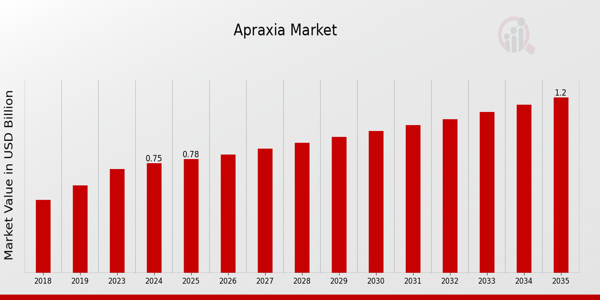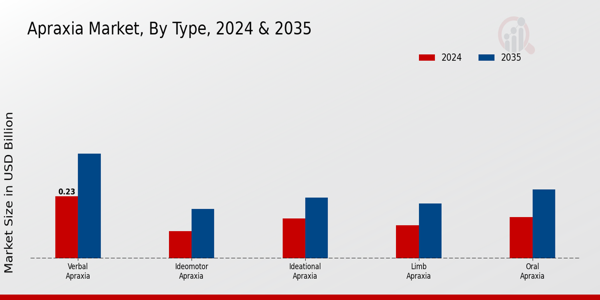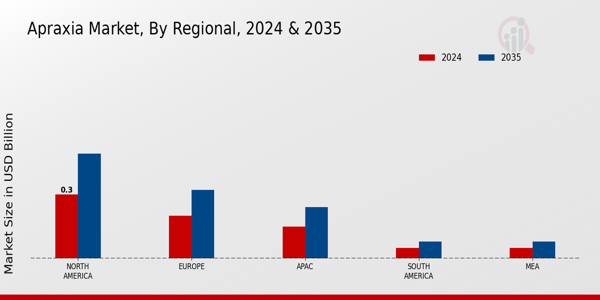Apraxia Market Overview
As per MRFR analysis, the Apraxia Market Size was estimated at 0.71 (USD Billion) in 2023.The Apraxia Market Industry is expected to grow from 0.75(USD Billion) in 2024 to 1.2 (USD Billion) by 2035.The Apraxia Market CAGR (growth rate) is expected to be around 4.43% during the forecast period (2025 - 2035).
Key Apraxia Market Trends Highlighted
The Global Apraxia Market is currently experiencing substantial market trends that are being driven by the growing recognition of apraxia as a neurological disorder that necessitates specialized care. The condition is being better managed as a result of the increasing awareness among healthcare professionals and the advancements in diagnostics, which are encouraging early intervention for patients.
The global geriatric population and the growing prevalence of neurodegenerative diseases are the primary market drivers that have contributed to the increased demand for effective therapeutic solutions. Fostering innovation in therapeutic techniques and the establishment of specialized training programs for speech-language pathologists can capitalize on opportunities in this market. Furthermore, the incorporation of telehealth solutions presents a promising opportunity to reach patients who may be marginalized or lack access to traditional therapies, particularly in rural or remote regions.
In recent years, there has been a rise in the popularity of home-based therapies and mobile applications that improve communication skills for individuals with apraxia, enabling more personalized and accessible interventions. Additionally, the development of targeted therapies and the advancement of research are being facilitated by the increasing prevalence of collaboration between academic institutions and pharmaceutical companies.
Government programs and campaigns in numerous regions are further supporting the momentum in this market, as evidenced by global initiatives that are designed to enhance awareness and education regarding apraxia.

Source: Primary Research, Secondary Research, MRFR Database and Analyst Review
Apraxia Market Drivers
Increasing Awareness and Diagnosis of Apraxia
The Global Apraxia Market Industry is witnessing growth driven by the increasing awareness and diagnosis of apraxia disorders among healthcare professionals and the general public. Recent statistics indicate that there is a growing recognition of neurological disorders, leading to a 15% increase in diagnoses over the last five years. Organizations such as the World Health Organization have launched campaigns to improve practitioner knowledge and patient education, thus driving an increase in diagnosed cases.
As healthcare providers become more vigilant in identifying symptoms related to apraxia, the number of diagnosed individuals climbs, facilitating market growth. The increase in diagnosed cases will directly boost the demand for therapeutic solutions, which are crucial for effective treatment and management of apraxia symptoms. Furthermore, advancements in diagnostic technologies and a more significant focus on neurological issues in primary care settings enhance the capacity for early diagnosis and intervention, further solidifying the growth trajectory of the Global Apraxia Market Industry.
Rising Investment in Research and Development
The Global Apraxia Market Industry is also being propelled by a surge in investment in Research and Development (R) initiatives specifically aimed at understanding and treating apraxia. In the last few years, funding for neurological research has seen an uptick of over 20%, as suggested by reports from various government health departments and established institutions. This investment is crucial for developing innovative treatment options and therapies tailored to the needs of apraxia patients.
Organizations like the National Institutes of Health (NIH) are allocating significant portions of their budgets to neurological research, which is expected to lead to groundbreaking discoveries and advancements in treatment methodologies. As more treatments enter the pipeline, it will not only enhance patient outcomes but also increase competitive dynamics within the market, attracting further investment and interest from stakeholders.
Growing Geriatric Population
The Global Apraxia Market Industry is significantly influenced by the growing geriatric population, which is particularly susceptible to neurodegenerative disorders, including apraxia. Current demographics show that by 2030, individuals aged 65 and older will outnumber children for the first time in history, according to data from the United Nations. This demographic shift means a greater prevalence of age-related neurological conditions, resulting in an increased demand for medical interventions related to apraxia.
Countries like Japan and Italy, which have some of the highest aging populations globally, are already experiencing a rise in cases and, consequently, a need for specialized therapeutic solutions. This trend necessitates that healthcare providers adapt their services to meet the demands of this age group, creating significant opportunities within the Global Apraxia Market Industry.
Apraxia Market Segment Insights
Apraxia Market Type Insights
The Global Apraxia Market has been distinctly categorized into different types, with each type showcasing unique characteristics and market valuations that reflect their respective importance in treating the condition. In 2024, the Verbal Apraxia segment is set to generate a notable share, valued at 0.225 USD Billion. It is projected to rise to 0.38 USD Billion by 2035, indicating its majority holding position within the market. This type is crucial as it directly affects an individual's ability to articulate words correctly, making effective communication a significant focus in therapeutic interventions.
Following closely, the Oral Apraxia segment is estimated to be valued at 0.15 USD Billion in 2024. It is expected to grow to 0.25 USD Billion by 2035, highlighting its essential role in managing and treating issues related to speech sounds and oral movements. Limb Apraxia holds a value of 0.12 USD Billion in 2024. It is anticipated to reach 0.2 USD Billion by 2035, emphasizing its significance in restoring motor actions necessary for daily tasks, creating an essential need for targeted therapies. The Ideomotor Apraxia segment is expected to see valuation changes from 0.1 USD Billion in 2024 to 0.18 USD Billion in 2035.
This particular type plays a vital role in enabling patients to perform purposeful movements in response to verbal commands, marking it as a significant area of focus within clinical settings. Lastly, the Ideational Apraxia segment, starting at 0.145 USD Billion in 2024 and reaching 0.22 USD Billion in 2035, underscores its importance as it affects the conception and execution of complex movements, which can be crucial in daily functional abilities.
The Global Apraxia Market’s segmentation reflects diverse challenges and needs; hence, understanding each type's specific role and growth potential is pivotal in devising tailored therapeutic strategies that can significantly influence treatment outcomes across varying patient populations.
This intricate landscape indicates considerable opportunities for advancements in clinical approaches and therapeutic modalities to address the unique challenges presented by each type of apraxia, driven by ongoing Research and Development efforts globally. Each segment's growth trajectory is fueled by increasing awareness and advancements in treatment protocols, emphasizing the need for integrative care strategies that cater to the multifaceted nature of apraxia.
As a result, stakeholders and healthcare providers continue to seek opportunities to enhance care provisions, which is projected to positively impact the Global Apraxia Market revenue and statistics moving forward, reinforcing the necessity for sustained focus on these critical segments.

Source: Primary Research, Secondary Research, MRFR Database and Analyst Review
Apraxia Market Diagnosis Method Insights
The Global Apraxia Market, particularly within the Diagnosis Method segment, plays a crucial role in the identification and evaluation of apraxia, expected to reach a valuation of 0.75 USD Billion by 2024. This segment consists of various approaches, including Clinical Assessment, which is vital for healthcare providers to diagnose the condition accurately, ensuring that patients receive appropriate therapy. Neuroimaging techniques have gained significance, providing visual insights into brain function and structure, which assist in understanding the neurological underpinnings of apraxia.
Standardized Tests are fundamental in quantifying the severity of the disorder, helping to set benchmarks for therapy outcomes. Parent and Teacher Reports are essential in gathering diverse observations that aid in making informed decisions about intervention strategies. This segment is expected to witness growth driven by increasing awareness of apraxia, advancements in technology, and the growing emphasis on early childhood education, presenting opportunities for innovation in diagnostic tools and methods, thus enhancing the overall Global Apraxia Market revenue.
Apraxia Market Age Group Insights
The Global Apraxia Market is expected to be valued at 0.75 USD Billion in 2024, reflecting a growing recognition of apraxia across various age groups, which include Children, Adults, and the Elderly. Children represent a significant portion of the market, as early diagnosis and intervention can greatly improve communication outcomes, showcasing a growing emphasis on pediatric healthcare and speech therapies. The adult segment also plays a crucial role, often linked with neurological conditions such as stroke or degenerative diseases, which drives demand for tailored therapeutic solutions.
Meanwhile, the elderly population is increasingly affected by age-related cognitive decline, emphasizing the need for specialized treatment options and services. Government initiatives aimed at mental health support and advancements in technology are driving market growth, while challenges such as awareness and accessibility of therapies remain. The overall Global Apraxia Market data reflects a steady growth trajectory fueled by an aging population and increased healthcare expenditures across the globe, highlighting key opportunities for stakeholders in this evolving industry.
Apraxia Market Treatment Approach Insights
The Global Apraxia Market is increasingly focusing on the Treatment Approach segment, which plays a pivotal role in enhancing the quality of life for individuals affected by apraxia. As of 2024, the overall market is valued at 0.75 billion USD, demonstrating significant potential for growth driven by rising awareness and advancements in therapeutic techniques. This segment encompasses various methods, including Speech Therapy, Occupational Therapy, Physical Therapy, and Alternative Therapies, each contributing to the holistic management of apraxia.
Speech Therapy stands out as a critical approach, addressing communication impairments, while Occupational Therapy focuses on improving daily living skills essential for independence. Physical Therapy is integral in enhancing motor skills and physical function, thus aiding overall rehabilitation. The growing adoption of Alternative Therapies also highlights a trend towards holistic care, tapping into various non-traditional methods. These approaches are vital as they cater to the diverse needs of patients, enabling tailored treatment plans that enhance recovery outcomes.
Government initiatives and educational programs are further reinforcing the importance of these treatment modalities, facilitating a more informed patient population. The combined efforts of these approaches form a comprehensive strategy to address the multifaceted challenges posed by apraxia, ultimately driving growth in the Global Apraxia Market industry.
Apraxia Market Regional Insights
The Global Apraxia Market is showing varying levels of growth across its regional segments, highlighting distinct characteristics and valuations. In 2024, North America is leading the market with a valuation of 0.3 USD Billion, projected to grow to 0.49 USD Billion by 2035, reflecting its significant demand for therapeutic interventions and healthcare advancements.
Europe follows closely, valued at 0.2 USD Billion in 2024 and anticipated to reach 0.32 USD Billion in 2035, indicating a strong investment in Research and Development. The APAC region, valued at 0.15 USD Billion in 2024 and predicted to grow to 0.24 USD Billion by 2035, is gaining traction due to its increasing population and healthcare initiatives.
South America and MEA each start at 0.05 USD Billion, with South America projected to grow to 0.08 USD Billion and MEA expected to reach the same in the same period, highlighting emerging opportunities despite currently lower market shares.
Overall, North America dominates the Global Apraxia Market due to its robust healthcare infrastructure, while APAC reflects significant growth potential driven by increasing access to healthcare resources.

Source: Primary Research, Secondary Research, MRFR Database and Analyst Review
Apraxia Market Key Players and Competitive Insights
The Global Apraxia Market has been steadily evolving, primarily driven by the increasing awareness of apraxia as a neurogenic speech disorder that significantly impacts communication. As research continues to advance, the demand for effective therapies and interventions has surged, prompting various companies to enter the market and innovate within this space.
This competition is characterized by a blend of biopharmaceutical firms, academic institutions, and research organizations focusing on developing new treatment modalities and improving existing therapeutic options. The growing prevalence of neurological disorders, along with the push for personalized medicine, is shaping the landscape, making understanding competitive insights crucial for stakeholders invested in the global apraxia sector.
Pfizer is a prominent player in the Global Apraxia Market, leveraging its extensive expertise in the pharmaceutical sector to develop innovative therapies catered to neurological conditions, including apraxia. The company has a strong global presence, which is supported by a well-established distribution network and a robust portfolio of market-ready products. Pfizer's investment in research and development has allowed it to remain competitive by focusing on improving patient outcomes and broadening its therapeutic offerings.
Additionally, the company's strategic initiatives aimed at forming partnerships with other biopharmaceutical firms and research organizations position it favorably within the Global Apraxia Market, ensuring that it can respond swiftly to emerging needs and continue to capture market share.Alnylam Pharmaceuticals is another critical entity in the Global Apraxia Market, known for its groundbreaking work in genetic medicine, particularly with RNA interference technologies.
The firm focuses on developing therapies for rare genetic diseases, including conditions that may lead to apraxia. Its key products have shown promise in addressing the underlying causes of neurological disorders, providing a strong foundation for Alnylam's competitive advantage. The company's market presence is bolstered by numerous partnerships and collaborations aimed at expanding its therapeutic reach and accelerating product development.
Alnylam's commitment to innovation, along with strategic mergers and acquisitions, enhances its capability to offer cutting-edge solutions in the Global Apraxia Market. Its strong pipeline of potential therapies aims to fill unmet needs within the neurology landscape, solidifying its position as a formidable competitor in this specialized market segment.
Key Companies in the Apraxia Market Include
- Pfizer
- Alnylam Pharmaceuticals
- Roche
- AbbVie
- Eli Lilly
- Boehringer Ingelheim
- GSK
- Johnson and Johnson
- Bristol Myers Squibb
- Novartis
- Teva Pharmaceutical
- Merck
- AstraZeneca
- Amgen
- Sanofi
Apraxia Market Industry Developments
Recent developments in the Global Apraxia Market reveal significant activity among major pharmaceutical companies. In October 2023, Pfizer announced advancements in apraxia treatment protocols aiming to enhance patient compliance and outcomes through innovative therapies.
Alnylam Pharmaceuticals has made headlines by expanding its product pipeline, focusing on rare genetic disorders, which may influence treatment options for apraxia patients. Roche is actively involved in research collaborations to develop novel therapeutics targeting speech apraxia.
At the same time, AbbVie and Eli Lilly have reported increased investments in Research and Development, specifically targeting neurodegenerative disorders linked to apraxia. Noteworthy mergers and acquisitions include AstraZeneca's acquisition of a biotechnology firm specializing in neurology in June 2023, enhancing its portfolio in this specialty area. Additionally, in September 2022, Johnson and Johnson completed the acquisition of a company focused on language disorders aimed at strengthening their neurology division.
Overall, the market is experiencing growth, with several companies showing increased valuations. The Global Apraxia Market is thus witnessing an evolving landscape with competitive dynamics reshaping treatment methodologies and corporate strategies.
Apraxia Market Segmentation Insights
Apraxia Market Type Outlook
- Verbal Apraxia
- Oral Apraxia
- Limb Apraxia
- Ideomotor Apraxia
- Ideational Apraxia
Apraxia Market Diagnosis Method Outlook
- Clinical Assessment
- Neuroimaging
- Standardized Tests
- Parent/Teacher Reports
Apraxia Market Age Group Outlook
Apraxia Market Treatment Approach Outlook
- Speech Therapy
- Occupational Therapy
- Physical Therapy
- Alternative Therapies
Apraxia Market Regional Outlook
- North America
- Europe
- South America
- Asia Pacific
- Middle East and Africa
| Report Attribute/Metric Source: |
Details |
| MARKET SIZE 2023 |
0.71(USD Billion) |
| MARKET SIZE 2024 |
0.75(USD Billion) |
| MARKET SIZE 2035 |
1.2(USD Billion) |
| COMPOUND ANNUAL GROWTH RATE (CAGR) |
4.43% (2025 - 2035) |
| REPORT COVERAGE |
Revenue Forecast, Competitive Landscape, Growth Factors, and Trends |
| BASE YEAR |
2024 |
| MARKET FORECAST PERIOD |
2025 - 2035 |
| HISTORICAL DATA |
2019 - 2024 |
| MARKET FORECAST UNITS |
USD Billion |
| KEY COMPANIES PROFILED |
Pfizer, Alnylam Pharmaceuticals, Roche, AbbVie, Eli Lilly, Boehringer Ingelheim, GSK, Johnson and Johnson, Bristol Myers Squibb, Novartis, Teva Pharmaceutical, Merck, AstraZeneca, Amgen, Sanofi |
| SEGMENTS COVERED |
Type, Diagnosis Method, Age Group, Treatment Approach, Regional |
| KEY MARKET OPPORTUNITIES |
Increasing awareness and diagnosis, Advancements in teletherapy solutions, Growing demand for speech therapy apps, Rising geriatric population prevalence, Expanding research funding initiatives |
| KEY MARKET DYNAMICS |
Increasing prevalence of neurological disorders, Growing awareness and diagnosis rates, Advancements in speech therapy techniques, Rising investment in research and development, Expanding healthcare infrastructure and access |
| COUNTRIES COVERED |
North America, Europe, APAC, South America, MEA |
Apraxia Market Highlights:
Frequently Asked Questions (FAQ) :
The Global Apraxia Market is expected to be valued at 0.75 USD Billion in 2024.
By 2035, the Global Apraxia Market is projected to reach 1.2 USD Billion.
The expected CAGR for the Global Apraxia Market from 2025 to 2035 is 4.43%.
North America is expected to dominate with a market value of 0.3 USD Billion in 2024.
Europe is projected to achieve a market value of 0.32 USD Billion in 2035.
Major players include Pfizer, Roche, AbbVie, and Johnson and Johnson among others.
The market size for Verbal Apraxia is valued at 0.225 USD Billion in 2024.
The Oral Apraxia market is expected to grow to 0.25 USD Billion by 2035.
Limb Apraxia is valued at 0.12 USD Billion and Ideomotor Apraxia at 0.1 USD Billion in 2024.
The APAC region is projected to reach a market size of 0.24 USD Billion by 2035.


















